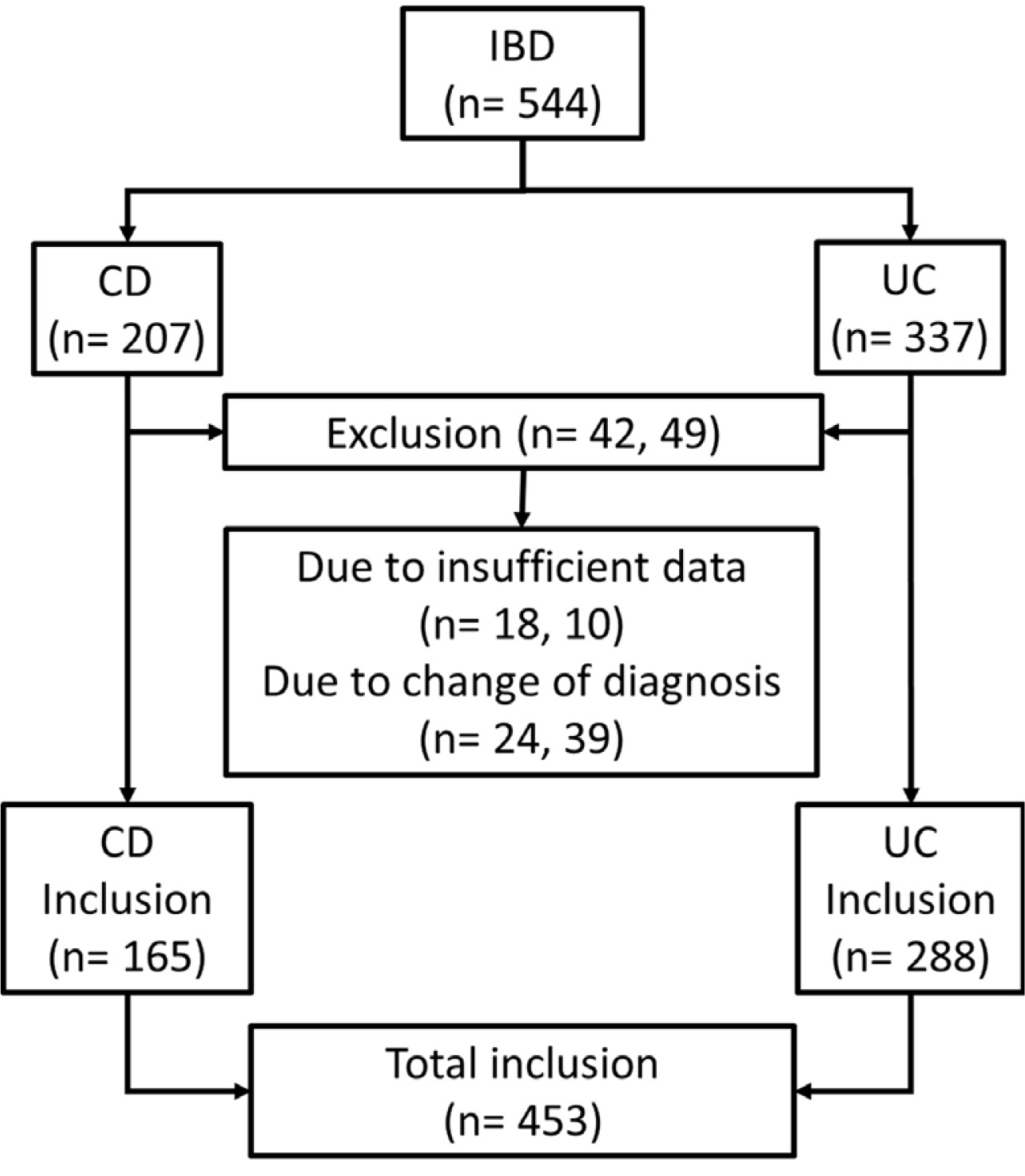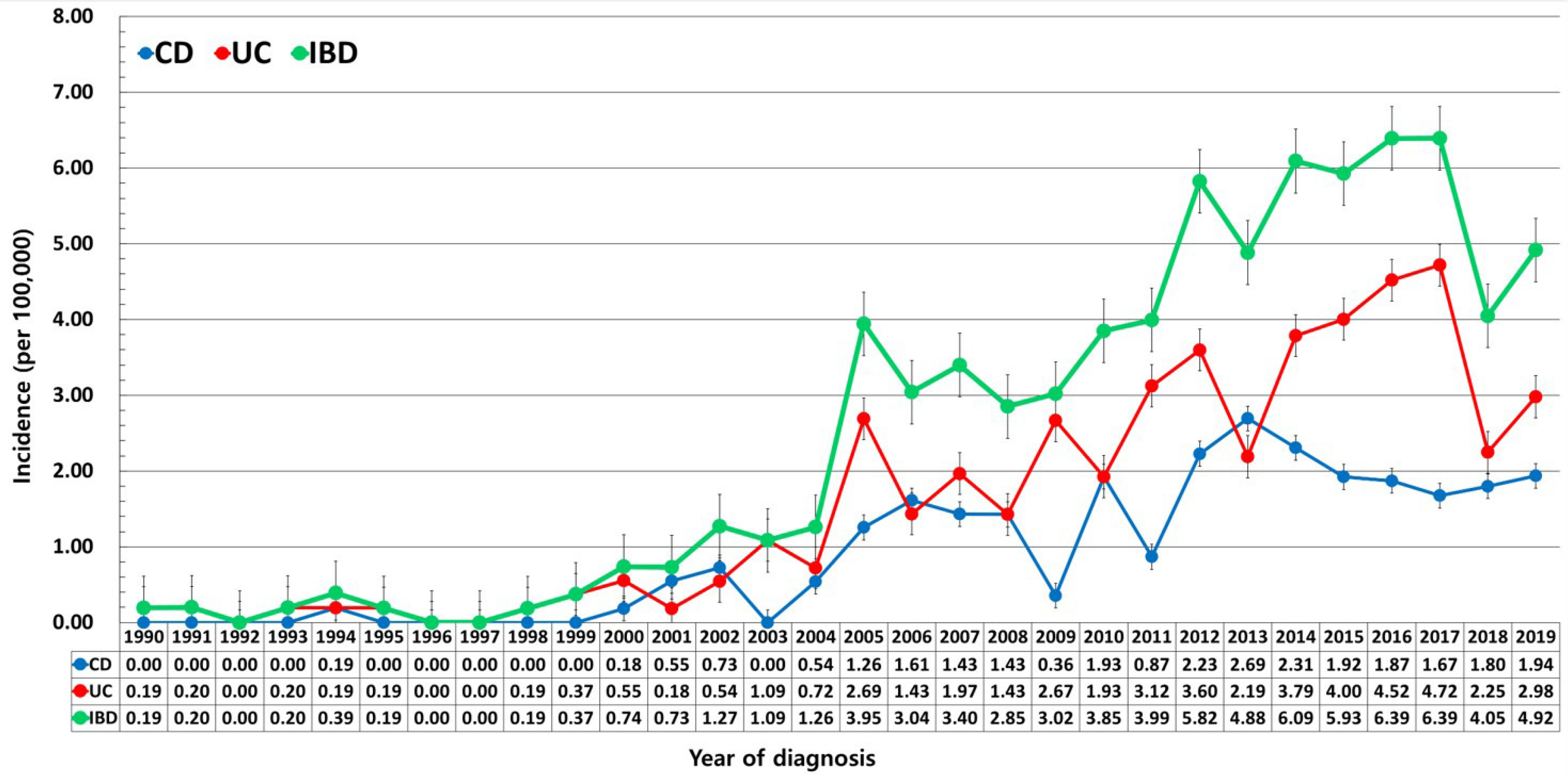Korean J Gastroenterol.
2023 Jun;81(6):243-252. 10.4166/kjg.2023.006.
Thirty-year Trend in Inflammatory Bowel Disease on Jeju Island, South Korea
- Affiliations
-
- 1Departments of Pediatrics Jeju National University College of Medicine, Jeju
- 2Departments of Internal Medicine, Jeju National University College of Medicine, Jeju
- 3Department of Internal Medicine, Incheon St. Mary's Hospital, College of Medicine, The Catholic University of Korea, Incheon, Korea
- KMID: 2543444
- DOI: http://doi.org/10.4166/kjg.2023.006
Abstract
- Background/Aims
Inflammatory bowel disease (IBD), including Crohn’s disease (CD) and ulcerative colitis (UC), is increasing in South Korea. On the other hand, there are no reports of the incidence and prevalence of IBD specific to Jeju Island, prompting the necessity of this study.
Methods
In this retrospective design, the medical records of 453 patients diagnosed with IBD at Jeju National University Hospital from January 1990 to December 2019 were analyzed.
Results
Of the 453 IBD subjects (165 CD, 288 UC) included, the UC: CD ratio was 1.75:1. The incidence of IBD increased continuously from 0.19/105 in 1990 to 6.39/105 in 2017 and after that decreased to 4.92/105 in 2019. The male:female ratio was 2.24:1 for CD and 1.29:1 for UC. In the CD subjects, the disease activity included remission (33.3%), mild (25.5%), moderate (30.9%), and severe (6.1%). In UC subjects, the disease activity included remission (24.0%), mild (35.4%), moderate (28.8%), and severe (6.2%). According to the Montreal classification, the cases were as follows: CD: terminal ileum (22.4%), colon (9.7%), ileocolon (66.1%), and upper gastrointestinal involvement (27.3%), and perianal fistula/abscess was present in 43.6% of subjects before or at diagnosis: UC: proctitis (43.4%), left-sided colitis (29.1%), and pancolitis (23.3%) at diagnosis.
Conclusions
The incidence of IBD on Jeju Island has increased steadily for approximately 30 years but has exhibited a decline since 2017. Therefore, the incidence of IBD in Jeju is believed to have plateaued. Further study will be needed for clarification. (Korean J Gastroenterol 2023;81:243-252)
Figure
Reference
-
1. Flynn S, Eisenstein S. 2019; Inflammatory bowel disease presentation and diagnosis. Surg Clin North Am. 99:1051–1062. DOI: 10.1016/j.suc.2019.08.001. PMID: 31676047.
Article2. Yu YR, Rodriguez JR. 2017; Clinical presentation of Crohn's, ulcerative colitis, and indeterminate colitis: Symptoms, extraintestinal manifestations, and disease phenotypes. Semin Pediatr Surg. 26:349–355. DOI: 10.1053/j.sempedsurg.2017.10.003. PMID: 29126502.
Article3. Greuter T, Piller A, Fournier N, et al. 2018; Upper gastrointestinal tract involvement in Crohn's disease: Frequency, risk factors, and disease course. J Crohns Colitis. 12:1399–1409. DOI: 10.1093/ecco-jcc/jjy121. PMID: 30165603.
Article4. Mak WY, Zhao M, Ng SC, Burisch J. 2020; The epidemiology of inflammatory bowel disease: East meets west. J Gastroenterol Hepatol. 35:380–389. DOI: 10.1111/jgh.14872. PMID: 31596960.
Article5. Ng SC, Tang W, Ching JY, et al. 2013; Incidence and phenotype of inflammatory bowel disease based on results from the Asia-pacific Crohn's and colitis epidemiology study. Gastroenterology. 145:158–165.e2. DOI: 10.1053/j.gastro.2013.04.007. PMID: 23583432.
Article6. Yang SK. 2017; How does the epidemiology of inflammatory bowel disease differ between east and west? A Korean perspective. Inflamm Intest Dis. 2:95–101. DOI: 10.1159/000454712. PMID: 30018960. PMCID: PMC5988201.
Article7. Ng SC, Shi HY, Hamidi N, et al. 2017; Worldwide incidence and prevalence of inflammatory bowel disease in the 21st century: a systematic review of population-based studies. Lancet. 390:2769–2778. Erratum in: Lancet 2020;396:e56. DOI: 10.1016/S0140-6736(17)32448-0. PMID: 29050646.
Article8. Windsor JW, Kaplan GG. 2019; Evolving epidemiology of IBD. Curr Gastroenterol Rep. 21:40. DOI: 10.1007/s11894-019-0705-6. PMID: 31338613.
Article9. Park SH, Kim YJ, Rhee KH, et al. 2019; A 30-year trend analysis in the epidemiology of inflammatory bowel disease in the Songpa-Kangdong District of Seoul, Korea in 1986-2015. J Crohns Colitis. 13:1410–1417. DOI: 10.1093/ecco-jcc/jjz081. PMID: 30989166.
Article10. Kwak MS, Cha JM, Lee HH, et al. 2019; Emerging trends of inflammatory bowel disease in South Korea: A nationwide population-based study. J Gastroenterol Hepatol. 34:1018–1026. DOI: 10.1111/jgh.14542. PMID: 30447025.
Article11. Kim HJ, Hann HJ, Hong SN, et al. Incidence and natural course of inflammatory bowel disease in Korea, 2006-2012: a nationwide population-based study. Inflamm Bowel Dis. 2015; 21:623–630. DOI: 10.1097/MIB.0000000000000313. PMID: 25647154.
Article12. Jung YS, Han M, Kim WH, Park S, Cheon JH. Incidence and clinical outcomes of inflammatory bowel disease in South Korea, 2011-2014: A nationwide population-based study. Dig Dis Sci. 2017; 62:2102–2112. DOI: 10.1007/s10620-017-4640-9. PMID: 28593437.
Article13. Hong SJ, Cho SM, Choe BH, et al. 2018; Characteristics and incidence trends for pediatric inflammatory bowel disease in Daegu-Kyungpook Province in Korea: a multi-center study. J Korean Med Sci. 33:e132. DOI: 10.3346/jkms.2018.33.e132. PMID: 29713253. PMCID: PMC5920122.
Article14. Statistics Korea. Korean Statistical Information Service. [Internet]. Available from: https://kosis.kr/statHtml/statHtml.do?orgId=101&tblId=DT_1B040A3&vw_cd=MT_ZTITLE&list_id=A_7&scrId=&seqNo=&lang_mode=ko&obj_var_id=&itm_id=&conn_path=MT_ZTITLE&path=%252FstatisticsList%252FstatisticsListIndex.do. Daejeon: Statistics Korea;updated 2019; cited 2019 Dec 31.15. Son JW, Han BD, Yang YS, et al. 2021 Obesity fact sheet. [Internet]. Korean Society for the Study of Obesity;2021. Available from: https://www.kosso.or.kr/file/2021_Obesity_Fact_Sheet_web_kor.pdf?v=2306260958.16. Lee KM, Kang EA, Kim HS, et al. 2020 Inflammatory Bowel Disease Fact Sheet in Korea. [Internet]. Korean Association for the Study of Intestinal Diseases;2020. Available from: https://www.kasid.org/sub07/IBD_fact_sheet.html.17. Ng WK, Wong SH, Ng SC. 2016; Changing epidemiological trends of inflammatory bowel disease in Asia. Intest Res. 14:111–119. DOI: 10.5217/ir.2016.14.2.111. PMID: 27175111. PMCID: PMC4863044.
Article18. Mokhtar NM, Nawawi KNM, Verasingam J, et al. 2019; A four-decade analysis of the incidence trends, sociodemographic and clinical characteristics of inflammatory bowel disease patients at single tertiary centre, Kuala Lumpur, Malaysia. BMC Public Health. 19(Suppl 4):550. DOI: 10.1186/s12889-019-6858-2. PMID: 31196184. PMCID: PMC6565539.
Article19. Shivashankar R, Tremaine WJ, Harmsen WS, Loftus EV Jr. 2017; Incidence and prevalence of Crohn's disease and ulcerative colitis in Olmsted County, Minnesota from 1970 through 2010. Clin Gastroenterol Hepatol. 15:857–863. DOI: 10.1016/j.cgh.2016.10.039. PMID: 27856364. PMCID: PMC5429988.
Article20. Song EM, Lee HS, Park SH, et al. 2018; Clinical characteristics and long-term prognosis of elderly onset ulcerative colitis. J Gastroenterol Hepatol. 33:172–179. DOI: 10.1111/jgh.13826. PMID: 28543366.
Article21. Song EM, Kim N, Lee SH, et al. 2018; Clinical characteristics and long-term prognosis of elderly-onset Crohn's disease. Scand J Gastroenterol. 53:417–425. DOI: 10.1080/00365521.2018.1437927. PMID: 29457917.
Article22. Statistics Korea. Korean Statistical Information Service. [Internet]. Daejeon: Statistics Korea;updated 2019; cited 2019 Dec 31. Available from: https://kosis.kr/statHtml/statHtml.do?orgId=101&tblId=DT_1B04005N&vw_cd=MT_ZTITLE&list_id=A_7&scrId=&seqNo=&lang_mode=ko&obj_var_id=&itm_id=&conn_path=MT_ZTITLE&path=%252FstatisticsList%252FstatisticsListIndex.do.23. Tran V, Limketkai BN, Sauk JS. 2019; IBD in the elderly: Management challenges and therapeutic considerations. Curr Gastroenterol Rep. 21:60. DOI: 10.1007/s11894-019-0720-7. PMID: 31776797.
Article24. Han M, Jung YS, Cheon JH, Park S. 2019; Regional variations in the use of biologics and immunomodulators among Korean patients with inflammatory bowel diseases. J Gastroenterol Hepatol. 34:1166–1174. DOI: 10.1111/jgh.14609. PMID: 30672608.
Article25. Na SY, Moon W. 2019; Perspectives on current and novel treatments for inflammatory bowel disease. Gut Liver. 13:604–616. DOI: 10.5009/gnl19019. PMID: 31195433. PMCID: PMC6860034.
Article26. Lee J, Im JP, Han K, et al. 2020; Changes in direct healthcare costs before and after the diagnosis of inflammatory bowel disease: A nationwide population-based study. Gut Liver. 14:89–99. DOI: 10.5009/gnl19023. PMID: 31158951. PMCID: PMC6974324.
Article27. Lee HS, Choe J, Lee HJ, et al. 2016; Change in the diagnosis of inflammatory bowel disease: a hospital-based cohort study from Korea. Intest Res. 14:258–263. DOI: 10.5217/ir.2016.14.3.258. PMID: 27433148. PMCID: PMC4945530.
Article28. Geboes K, Colombel JF, Greenstein A, et al. 2008; Indeterminate colitis: a review of the concept--what's in a name? Inflamm Bowel Dis. 14:850–857. DOI: 10.1002/ibd.20361. PMID: 18213696.29. Guindi M, Riddell RH. 2004; Indeterminate colitis. J Clin Pathol. 57:1233–1244. DOI: 10.1136/jcp.2003.015214. PMID: 15563659. PMCID: PMC1770507.
Article30. Khalili H, Burke KE, Roelstraete B, Sachs MC, Olén O, Ludvigsson JF. 2020; Microscopic colitis and risk of inflammatory bowel disease in a nationwide cohort study. Gastroenterology. 158:1574–1583.e2. DOI: 10.1053/j.gastro.2019.12.028. PMID: 31926169.
Article
- Full Text Links
- Actions
-
Cited
- CITED
-
- Close
- Share
- Similar articles
-
- Epidemiologic characteristics of scrub typhus on Jeju Island
- A Epidemic Survey of the Shigellosis in Jeju Island during the First Half of Year 2000
- The First Case of Non-retrospective Clinical Identification of Severe Fever with Thrombocytopenia Syndrome Patient in 2013 in South Korea
- Asian Physician's Perspectives on Biosimilars in Inflammatory Bowel Disease: Are We Ready to Use?
- Phylogenetic Analysis for the Origin of Typhoid Fever Outbreak on Jeju Island, Korea, in 2017




